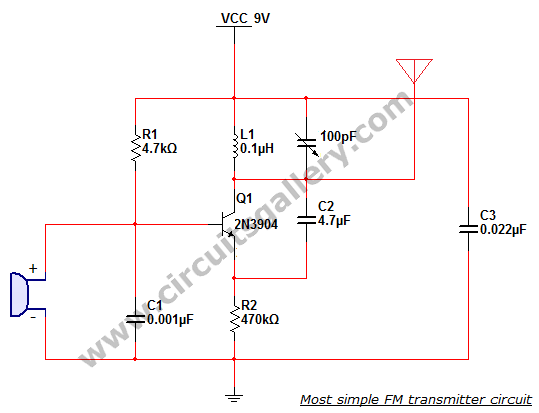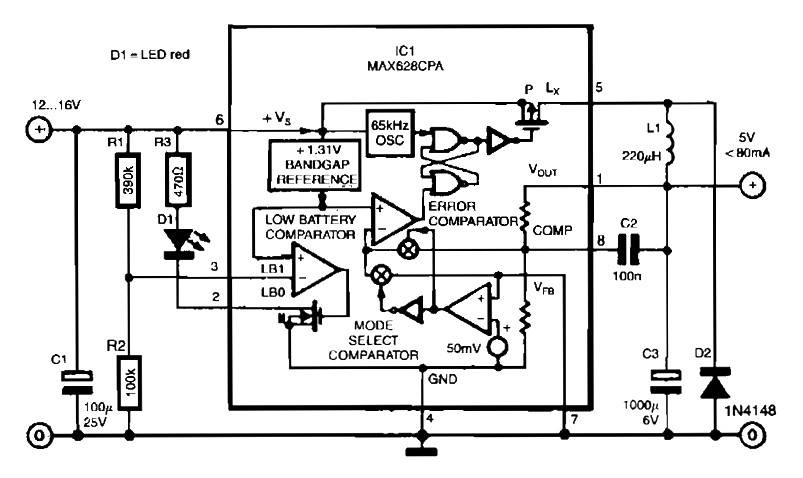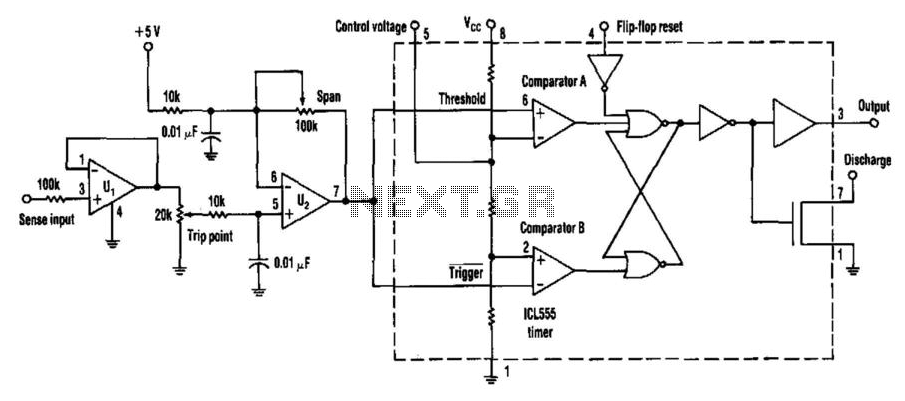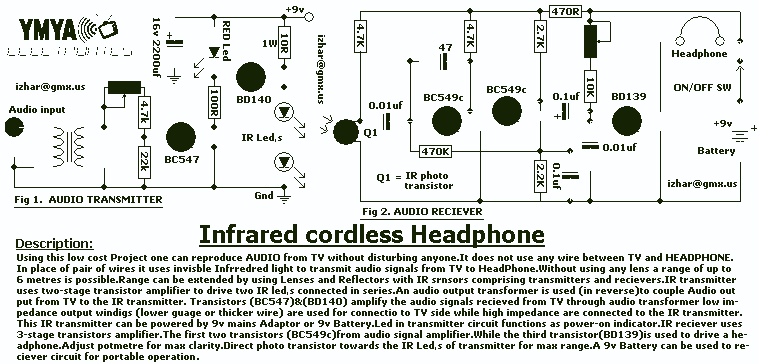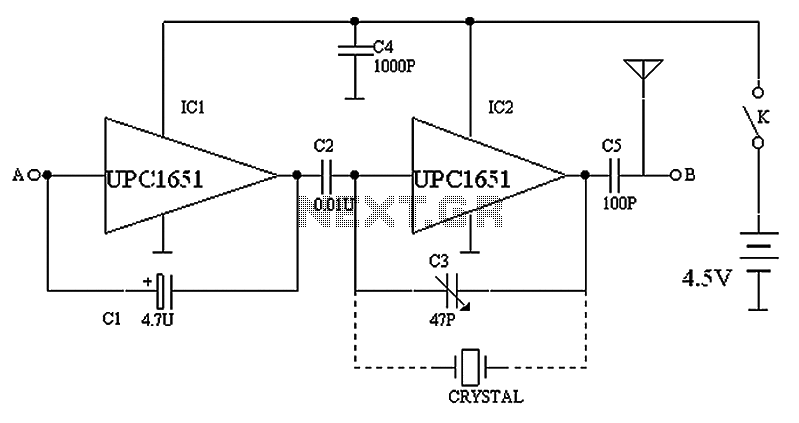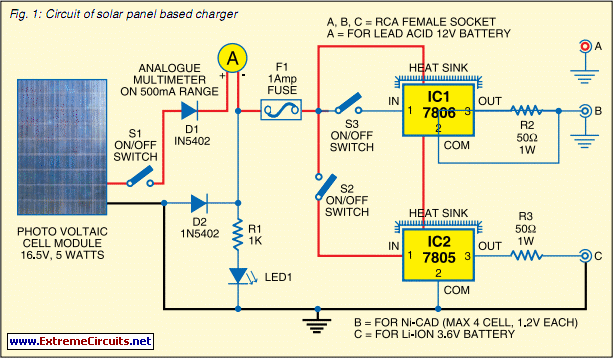
Water Tank Controller Circuit PCB
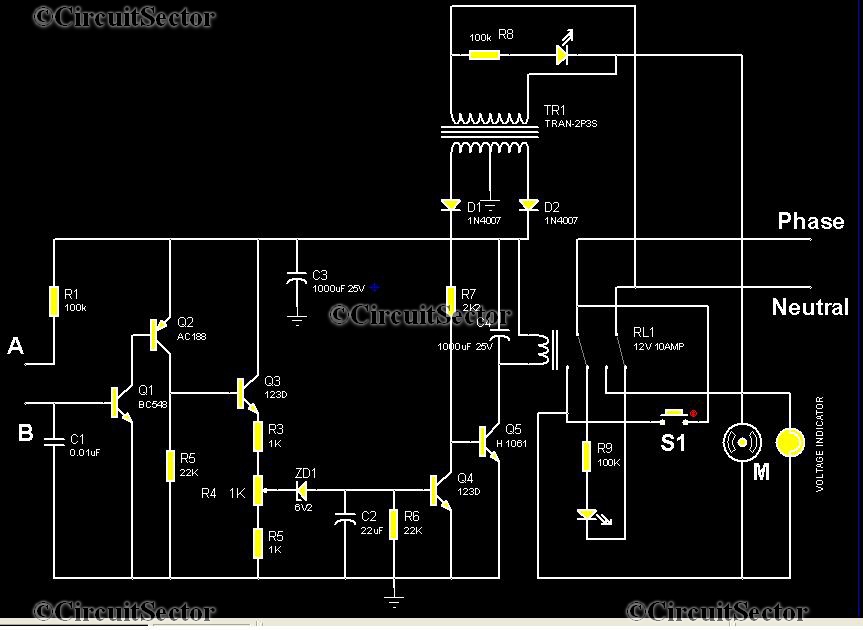
This is an automatic water tank controller designed to manage the operation of a water pump using a 12V 10A relay. When the water level in the tank creates a short circuit between points A and B in the circuit diagram, the pump is automatically turned off. This home water pump controller circuit is relatively simple and low-cost, making it easy to assemble on a common PCB. The circuit schematic diagram of the tank controller is provided in the accompanying image. When switch S1 is pressed, a biasing voltage is applied to transistor Q1 through resistor R1, activating the relay and turning on the connected pump. The terminals A and B should be positioned at the upper side of the water tank. When the water level short circuits these points, transistor Q1 is activated, causing the relay to disconnect power and turning off the motor.
The automatic water tank controller circuit operates using a straightforward configuration that includes essential components: a relay, a transistor, a switch, and resistors. The relay serves as the main switching device that controls the water pump, allowing it to turn on or off based on the water level detected in the tank. The relay is rated for 12V and 10A, ensuring it can handle the load of the water pump effectively.
In the circuit, the switch S1 is used to manually initiate the pump operation. When pressed, it allows current to flow through resistor R1, which in turn biases transistor Q1 into conduction. This action energizes the relay coil, closing the relay contacts and allowing current to flow to the water pump. The pump will then operate to fill the tank.
The critical aspect of this design is the placement of terminals A and B, which serve as the water level sensors. These terminals are designed to be submerged at a predetermined level in the tank. When the water rises to this level, it creates a conductive path between A and B, effectively short-circuiting them. This condition causes transistor Q1 to remain in the ON state, which keeps the relay de-energized. Consequently, the relay contacts open, cutting off the power supply to the water pump and stopping its operation.
This automatic water tank controller circuit is an efficient solution for maintaining optimal water levels in tanks without manual intervention. Its simplicity and low cost make it suitable for various applications, including residential water systems and agricultural setups. Additionally, the use of a PCB for assembly enhances reliability and reduces the chances of wiring errors during installation. Overall, the described circuit is an effective method for automating water tank management, ensuring that the pump operates only when necessary.Here is an automatic water tank controller that controls the operation of a water pump through a 12V 10amp relay. When ever the water level of the tank short circuits the points A and B in the circuit diagram, the pump get turned off automatically.
This home water pump controller circuit is comparably simple and low cost and can be assembled easil y on a common PCB. The circuit schematic diagram of the tank controlller is given on the image. Whe the switch S1 in the circuit is pressed, a biasing will get to the transistor Q1 through resistor R1 and the relay will be turned on. So the pump connected on the relay will also switched on. We can place the terminals A and B in the upper side of the water tank. Whenever the water shortcircuits these points, the Q1 transistor will be on and the relay will cuttoff and the motor also turned off.
🔗 External reference
The automatic water tank controller circuit operates using a straightforward configuration that includes essential components: a relay, a transistor, a switch, and resistors. The relay serves as the main switching device that controls the water pump, allowing it to turn on or off based on the water level detected in the tank. The relay is rated for 12V and 10A, ensuring it can handle the load of the water pump effectively.
In the circuit, the switch S1 is used to manually initiate the pump operation. When pressed, it allows current to flow through resistor R1, which in turn biases transistor Q1 into conduction. This action energizes the relay coil, closing the relay contacts and allowing current to flow to the water pump. The pump will then operate to fill the tank.
The critical aspect of this design is the placement of terminals A and B, which serve as the water level sensors. These terminals are designed to be submerged at a predetermined level in the tank. When the water rises to this level, it creates a conductive path between A and B, effectively short-circuiting them. This condition causes transistor Q1 to remain in the ON state, which keeps the relay de-energized. Consequently, the relay contacts open, cutting off the power supply to the water pump and stopping its operation.
This automatic water tank controller circuit is an efficient solution for maintaining optimal water levels in tanks without manual intervention. Its simplicity and low cost make it suitable for various applications, including residential water systems and agricultural setups. Additionally, the use of a PCB for assembly enhances reliability and reduces the chances of wiring errors during installation. Overall, the described circuit is an effective method for automating water tank management, ensuring that the pump operates only when necessary.Here is an automatic water tank controller that controls the operation of a water pump through a 12V 10amp relay. When ever the water level of the tank short circuits the points A and B in the circuit diagram, the pump get turned off automatically.
This home water pump controller circuit is comparably simple and low cost and can be assembled easil y on a common PCB. The circuit schematic diagram of the tank controlller is given on the image. Whe the switch S1 in the circuit is pressed, a biasing will get to the transistor Q1 through resistor R1 and the relay will be turned on. So the pump connected on the relay will also switched on. We can place the terminals A and B in the upper side of the water tank. Whenever the water shortcircuits these points, the Q1 transistor will be on and the relay will cuttoff and the motor also turned off.
🔗 External reference
